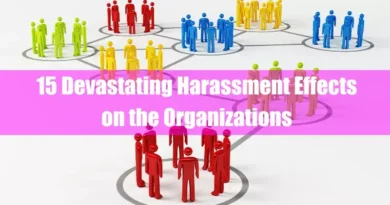LGBTQ+ Vulnerability: Addressing Sexual Harassment
LGBTQ+ individuals encounter specific challenges related to sexual harassment, often intensified by societal biases and the absence of inclusive policies. Addressing these vulnerabilities requires a multi-faceted approach.
Organizations need comprehensive anti-harassment policies that explicitly protect sexual orientation and gender identity. Regular sensitivity training on LGBTQ+ issues is also essential. Establishing support systems and ensuring accessible, confidential reporting mechanisms are crucial.
Effective enforcement through prompt investigations and appropriate disciplinary actions fosters a safe and respectful environment. These measures, supported by organizations like the U.S. Department of Justice Civil Rights Division and the EEOC, are vital in combating harassment and supporting LGBTQ+ individuals in various settings, from workplaces to public spaces.
By adopting these strategies, organizations can better support LGBTQ+ individuals, creating safer and more inclusive environments.
Takeaways
| Key Points |
|---|
| LGBTQ+ individuals face heightened vulnerability to harassment due to societal prejudices, systemic discrimination, and historical stigmatization rooted in legal inequities and cultural biases. |
| Sexual harassment, encompassing verbal, physical, and online forms, occurs across workplaces, schools, and public spaces, creating hostile environments that lead to severe psychological, emotional, and physical consequences. |
| Studies, such as the Williams Institute’s research, reveal that nearly 45.5% of LGBTQ+ workers experience workplace harassment, and 47% of transgender individuals report lifetime sexual assault, highlighting the pervasive nature of these challenges. |
| While some progress has been made, like the U.S. Supreme Court’s Bostock v. Clayton County decision protecting LGBTQ+ individuals under Title VII, gaps in protections persist globally, exacerbating issues like housing discrimination and public space harassment. |
| Inclusive anti-harassment policies, incorporating clear definitions, robust reporting mechanisms, training programs, and support systems, as seen in successful cases like Google’s initiatives, are essential to creating safer environments and promoting equality for LGBTQ+ individuals. |
Introduction
LGBTQ+ individuals are particularly susceptible to harassment due to societal prejudices and systemic discrimination. Vulnerability in this context refers to the heightened risk and exposure to harm that LGBTQ+ individuals face, specifically related to their sexual orientation and gender identity.
This vulnerability is rooted in historical stigmatization, legal inequities, and pervasive cultural biases that perpetuate environments where harassment can thrive.
Sexual harassment encompasses a range of unwelcome behaviors of a sexual nature that can occur in various settings, including the workplace, schools, and public spaces. It includes verbal harassment, physical harassment, and online harassment.
Sexual harassment not only undermines the dignity of the individual but also creates hostile environments that can lead to severe psychological, emotional, and physical consequences. For LGBTQ+ individuals, these experiences are often compounded by additional layers of discrimination based on their sexual orientation or gender identity.
Understanding LGBTQ+ Vulnerability
Historical Context
The historical context of LGBTQ+ vulnerability is marked by a long-standing struggle for recognition and rights. Throughout history, LGBTQ+ individuals have faced criminalization, medicalization, and social ostracization.
The Stonewall Riots of 1969 were pivotal, sparking the modern LGBTQ+ rights movement. Despite progress, the legacy of discrimination continues to affect the lives of LGBTQ+ individuals today.
Current Legal Protections
Legal protections for LGBTQ+ individuals vary significantly across different regions. In the United States, the Supreme Court’s 2020 decision in Bostock v. Clayton County affirmed that discrimination based on sexual orientation or gender identity is prohibited under Title VII of the Civil Rights Act of 1964.
However, gaps in legal protections persist, particularly at the state level and in other countries, where LGBTQ+ individuals may still face legal and social challenges.
Statistics on LGBTQ+ Harassment
Statistics reveal the stark reality of harassment faced by LGBTQ+ individuals. According to various studies by the Williams Institute at UCLA School of Law, a significant portion of LGBTQ+ individuals have reported experiencing harassment based on their sexual orientation or gender identity.
For example, one study indicates that approximately 45.5% of LGBTQ+ workers have faced discrimination or harassment at work at some point in their lives. These findings highlight the pervasive nature of harassment faced by LGBTQ+ individuals.
The National Center for Transgender Equality’s 2015 U.S. Transgender Survey found that 47% of transgender individuals experienced sexual assault at some point in their lives. These figures underscore the pervasive nature of harassment in the lives of LGBTQ+ individuals.

Types of Sexual Harassment Faced by LGBTQ+ Individuals
Verbal Harassment
Verbal harassment includes derogatory comments, slurs, and threats based on an individual’s sexual orientation or gender identity. This harassment can occur in various settings, such as workplaces, schools, and public spaces.
Verbal harassment demeans the individual and creates a climate of fear and hostility. For LGBTQ+ individuals, verbal harassment often intersects with other forms of discrimination, amplifying its impact.
Physical Harassment
Physical harassment involves unwanted physical contact or threats of violence. LGBTQ+ individuals are at a higher risk of physical harassment, which can range from inappropriate touching to outright assault.
The 2015 U.S. Transgender Survey reported that nearly one in ten (specifically, 9%)respondents experienced physical violence in the workplace due to their gender identity. Physical harassment poses significant safety risks and can lead to severe physical and psychological trauma.
Online Harassment
Online harassment has become increasingly prevalent with the rise of social media and digital communication platforms. LGBTQ+ individuals often face cyberbullying, doxxing, and online threats.
The anonymity provided by the internet often encourages harassers, making it a challenging issue to address. Online harassment can have real-world consequences, including psychological distress and threats to personal safety.
Workplace Harassment
Workplace harassment remains a significant issue for LGBTQ+ individuals. This includes not only overt actions such as sexual advances and inappropriate comments but also subtle forms of discrimination like exclusion and differential treatment.
The Human Rights Campaign’s 2021 Workplace Equality Index found that 46% of LGBTQ+ workers remained closeted at work due to fear of discrimination. Effective workplace policies and inclusive cultures are critical in mitigating these risks.
Housing and Public Spaces Harassment
Harassment in housing and public spaces further marginalizes LGBTQ+ individuals. This includes discrimination by landlords, hostility from neighbors, and harassment in public areas.
Several studies have shown that same-sex couples were less likely to receive responses to rental inquiries compared to opposite-sex couples. Such harassment limits access to safe and stable housing, exacerbating the vulnerability of LGBTQ+ individuals.

Creating Inclusive Policies
Importance of Comprehensive Anti-Harassment Policies
Comprehensive anti-harassment policies are crucial in protecting LGBTQ+ individuals. These policies must explicitly include protections based on sexual orientation and gender identity.
The EEOC emphasizes that inclusive policies safeguard individuals and promote a respectful and productive environment. Organizations that adopt these policies demonstrate a commitment to equality and foster a culture of respect.
Key Components of Effective Policies
Effective anti-harassment policies should encompass several key components:
- Clear Definitions: Define harassment, including examples specific to LGBTQ+ individuals.
- Reporting Mechanisms: Provide accessible and confidential ways to report harassment.
- Training Programs: Implement regular training to educate employees about LGBTQ+ issues and sensitivity.
- Enforcement Procedures: Ensure prompt investigation and disciplinary actions for violations.
- Support Systems: Establish resources like counseling and LGBTQ+ support groups.
Case Studies of Successful Implementation
Several organizations have successfully implemented inclusive policies.
For instance, Google has been recognized for its comprehensive anti-harassment policy that includes protections for LGBTQ+ employees. Their policy features mandatory training, robust reporting mechanisms, and strong enforcement procedures.
Such case studies illustrate the positive impact of inclusive policies on organizational culture and employee well-being.
Education and Training
Mandatory Training Programs
Mandatory training programs are essential in educating employees about harassment and fostering a culture of inclusion. These programs should cover the basics of sexual harassment, legal protections, and specific challenges faced by LGBTQ+ individuals.
Training should be regularly updated to reflect current issues and best practices.
Sensitivity Training on LGBTQ+ Issues
Sensitivity training goes beyond basic harassment education to address specific LGBTQ+ issues. This includes understanding gender identity, sexual orientation, and the unique challenges LGBTQ+ individuals face.
Sensitivity training helps create a more empathetic and inclusive environment. It can also reduce unconscious biases and promote respectful interactions.
Resources and Tools for Effective Training
Various resources and tools are available to support effective training. The EEOC provides guidelines and training materials that organizations can use.
Additionally, partnering with LGBTQ+ advocacy groups can enhance training programs by providing expert insights and real-life perspectives. Online platforms and workshops can also offer interactive and engaging training experiences.
Support Systems for LGBTQ+ Individuals
Establishing Resource Groups
Resource groups are crucial in supporting and fostering a community for LGBTQ+ individuals. These groups, often called Employee Resource Groups (ERGs) or affinity groups, offer a safe space for members to share their experiences, seek advice, and advocate for their needs within the organization.
ERGs can organize events, workshops, and networking opportunities, which help build a supportive network and promote understanding among all employees. They also serve as a platform for raising awareness about LGBTQ+ issues and driving policy changes within the organization.
Providing Counseling Services
Access to counseling services is vital for LGBTQ+ individuals who experience harassment. Professional counseling provides a confidential and supportive environment where individuals can discuss their experiences and receive psychological support. Counseling services can help mitigate the mental health impacts of harassment, such as anxiety, depression, and trauma.
Organizations should offer counseling through Employee Assistance Programs (EAPs) or partner with external mental health providers to ensure employees can access necessary resources. This support benefits the individual’s well-being and contributes to a healthier and more productive work environment.
Creating Safe Spaces
Creating safe spaces within the workplace and the broader community is essential for the well-being of LGBTQ+ individuals. Safe spaces are environments where LGBTQ+ individuals can feel secure, respected, and free from harassment.
This can include designated areas in the workplace, such as private rooms for support meetings and inclusive policies that protect against discrimination. Safe spaces extend beyond physical locations to virtual spaces, such as online support groups and forums.
These spaces provide a refuge from hostility and allow individuals to express themselves openly and authentically.

Reporting Mechanisms
Accessible and Confidential Reporting Processes
Effective reporting mechanisms are critical for addressing harassment. These processes should be easily accessible and allow individuals to report incidents confidentially. Accessibility involves having multiple reporting channels, such as hotlines, online forms, and in-person reporting options, to accommodate different preferences and needs.
Confidentiality is paramount to protect the individual’s privacy and encourage more victims to come forward without fear of exposure. Organizations should ensure these processes are user-friendly and clearly communicated to all employees.
Protecting Anonymity and Privacy
Protecting the anonymity and privacy of individuals who report harassment is essential to foster trust in the reporting system. This can be achieved by allowing anonymous reporting options and ensuring that all reports are handled carefully.
Information about the incident should be shared only on a need-to-know basis, and the reporter’s identity should be protected throughout the investigation process.
Ensuring privacy can significantly increase the likelihood that victims will report harassment, knowing that their identity and details will be safeguarded.
Encouraging Reporting without Fear of Retaliation
Fear of retaliation is a significant barrier to reporting harassment. Organizations must take proactive steps to assure employees they can report incidents without fear of adverse consequences.
This includes implementing and enforcing anti-retaliation policies that protect reporters from retaliation, such as demotion, dismissal, or workplace ostracism. Clear communication about these protections and visible support from leadership can help create an environment where employees feel safe to report harassment.
Training managers and supervisors on handling reports and ensuring non-retaliatory behavior is also crucial.
Enforcement and Accountability
Ensuring Prompt Investigations
Prompt and thorough investigations are vital to address harassment effectively. Organizations must have a clear process in place for investigating harassment complaints, which includes timelines for different stages of the investigation.
Quick responses help resolve issues and demonstrate the organization’s commitment to a harassment-free environment. Investigations should be conducted by trained personnel who understand LGBTQ+ issues and are equipped to handle such cases with sensitivity and impartiality.
Disciplinary Actions for Perpetrators
Holding perpetrators accountable through appropriate disciplinary actions is essential to deter harassment and reinforce organizational policies. Disciplinary actions should be consistent and proportionate to the severity of the offense, ranging from warnings to termination of employment.
Transparent communication about the consequences of harassment can serve as a deterrent and reassure employees that the organization takes such matters seriously. Additionally, providing support to victims throughout the process helps in their recovery and reinforces the organization’s commitment to their well-being.
Monitoring and Evaluating Policy Effectiveness
Regular monitoring and evaluation of harassment policies are necessary to ensure their effectiveness. Organizations should collect data on reported incidents, outcomes of investigations, and employee feedback to assess their policies impact.
This information can identify areas for improvement and help update policies to reflect best practices and emerging issues. Periodic reviews and audits of the policies and procedures also ensure that they remain relevant and effective in addressing harassment and supporting LGBTQ+ individuals.
Conclusion
Addressing the vulnerability of LGBTQ+ individuals to sexual harassment requires a comprehensive and proactive approach. Establishing robust support systems, creating accessible reporting mechanisms, and ensuring strict enforcement and accountability are critical components of this effort.
Real-life examples and case studies illustrate the positive impact of these measures and provide valuable insights for organizations seeking to create safer and more inclusive environments.
By continuously monitoring and updating policies, organizations can better protect their LGBTQ+ employees and foster a culture of respect and equality.
FAQ
What is ‘Misgendering’ in the context of sexual harassment?
Misgendering refers to addressing or referring to someone using pronouns or terms that do not align with their affirmed gender identity. In the context of sexual harassment, deliberate misgendering can create a hostile environment, undermining an individual’s dignity and contributing to discrimination. Such actions can exacerbate feelings of vulnerability among transgender and non-binary individuals.
Can you explain ‘Deadnaming’ and its impact on LGBTQ+ individuals?
Deadnaming involves calling a transgender person by their birth name after they have changed it as part of their transition. This act can be distressing and invalidating, especially when done intentionally, as it disregards their gender identity and can be a form of harassment. Deadnaming contributes to a hostile environment, affecting the individual’s mental well-being and sense of safety.
What does ‘Outing’ mean, and why is it considered harmful?
‘Outing’ is the act of revealing someone’s sexual orientation or gender identity without their consent. This violation of privacy can lead to discrimination, stigmatization, and even physical harm, particularly in environments that are not accepting of LGBTQ+ identities. Outing undermines an individual’s autonomy over their personal information and can have severe emotional and social repercussions.
Define ‘Heteronormativity’ and its relation to workplace harassment.
Heteronormativity is the assumption that heterosexuality is the default or normal sexual orientation, leading to the marginalization of LGBTQ+ identities. In the workplace, heteronormative cultures can perpetuate environments where non-heterosexual orientations are ignored or devalued, potentially fostering discriminatory practices and harassment. This bias can manifest in policies, language, and behaviors that exclude or stigmatize LGBTQ+ individuals.
What is ‘Cisnormativity,’ and how does it affect transgender employees?
Cisnormativity is the assumption that being cisgender—identifying with the sex assigned at birth—is the norm, thereby marginalizing transgender and non-binary identities. This perspective can lead to workplace policies and cultures that do not acknowledge or respect the identities of transgender employees, increasing their vulnerability to harassment and discrimination. Such environments can impede their career progression and overall well-being.
Explain ‘Microaggressions’ and their impact on LGBTQ+ individuals.
Microaggressions are subtle, often unintentional, comments or actions that convey prejudice towards marginalized groups. For LGBTQ+ individuals, microaggressions can include assumptions about their relationships or inappropriate questioning about their personal lives. These seemingly minor incidents can accumulate over time, leading to significant stress and a diminished sense of belonging in the workplace.
What does ‘Tokenism’ mean concerning LGBTQ+ workplace inclusion?
Tokenism occurs when organizations make superficial efforts to include members of marginalized groups, such as hiring a minimal number of LGBTQ+ individuals, without genuine inclusion. This practice can lead to isolation, increased scrutiny, and additional pressure on the tokenized individuals, as their presence is often used to suggest diversity without addressing systemic issues.
Define ‘Biphobia’ and its manifestation in professional settings.
Biphobia is the aversion or discrimination against bisexual individuals. In professional settings, biphobia can manifest through invalidation of bisexuality, such as suggesting it’s a phase or exclusion from LGBTQ+ initiatives. This discrimination contributes to a hostile work environment and can discourage bisexual employees from being open about their identity.
Can you explain ‘Transphobia’ and its implications in the workplace?
Transphobia refers to the fear, hatred, or discrimination against transgender individuals. In the workplace, transphobia can result in exclusionary policies, refusal to use correct pronouns or denial of access to appropriate facilities. Such behaviors create unsafe environments, hindering the professional growth and mental health of transgender employees.
What is ‘Internalized Homophobia,’ and how might it affect an employee’s performance?
Internalized homophobia occurs when LGBTQ+ individuals internalize societal negative attitudes toward their own sexual orientation. This internal conflict can lead to low self-esteem, anxiety, and reluctance to disclose their identity, adversely affecting their job performance and workplace relationships.
Define ‘Allyship’ in the context of supporting LGBTQ+ colleagues.
Allyship involves individuals who do not identify as LGBTQ+ actively supporting and advocating for the rights and inclusion of LGBTQ+ people. Effective allyship includes challenging discriminatory behaviors, promoting inclusive policies, and creating a supportive environment that acknowledges and respects diverse identities.
What does ‘Two-Spirit’ mean, and how should workplaces accommodate such identities?
‘Two-Spirit’ is a term some Indigenous cultures in North America use to describe a person embodying both masculine and feminine qualities. Workplaces should recognize and respect Two-Spirit identities by fostering cultural sensitivity, providing appropriate training, and ensuring that policies include diverse gender identities beyond the Western binary framework.
Explain ‘Intersectionality’ and its importance in addressing sexual harassment.
Intersectionality is a framework that examines how various social identities, such as race, gender, sexuality, and class, intersect to create unique experiences of oppression or privilege. Understanding intersectionality is crucial in addressing sexual harassment, as it highlights that LGBTQ+ individuals may face compounded discrimination based on multiple aspects of their identity, necessitating more nuanced and comprehensive protective measures.
What is ‘Queerphobia,’ and how can organizations combat it?
Queerphobia is the fear or hatred of individuals who identify as queer, encompassing a range of non-normative sexual orientations and gender identities. Organizations can combat queerphobia by implementing inclusive policies, providing education on diverse identities, and fostering a culture that celebrates rather than marginalizes differences.









